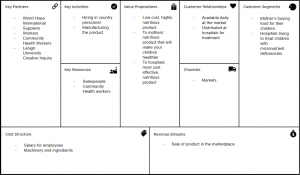When developing a product to combat malnutrition in Sierra Leone for the 6-24 month age group, cultural issues are certainly our most prominent barrier. For starters, families in Sierra Leone are used to cooking the same meals for generations and serving it to their entire family without seeing any immediate issue—okra stew, cassava bread, and lots of rice, for instance—if this is what the parents grew up eating and they are just fine, who’s to tell them to change their ways? And more importantly, how can we not only convince them to supplement their meals, but moreover, buy our product instead of anything else on the market. In order to try and differentiate our product and also simplify it for consumers, the next obstacle for us to tackle would be scarce access to clean water. If we could make a product that entirely cuts out the process of retrieving and boiling water to prepare a meal for their children, it might be easy enough for them to want to buy and thus, easier to integrate into their dietary habits. A third cultural barrier would stem from marketing. How can we get our product to be appealing enough that mother’s see the need to go out of their way, purchase our product, and feed it to their children, instead of something that is already a part of their normal routine and in their household. Will it be adaptable and will it be practical for the consumers. It is hard to do this when our product is designed for children as young as 6 months old, because they cannot speak for themselves and convince the mothers to buy something out of pure want. Therefore, our product will have to be simple and appealing nutritionally and commercially to the parents if we want to be successful.
I think when it comes to issues like habit, traditional diet, and attraction toward products, these things are frequently seen even in America. People generally do not like change, and that is simply because you cannot change an entire culture. What one group may see as wrong and need fixing, another may have a completely viable reason for maintaining. Like the example in the Ted Talk that discussed perspectives and how cities here divide areas by naming and numbering streets, whereas some Asia countries divided areas by numbering the blocks between the streets. Moreover, when you break this down to a dietary standpoint, as a daughter of two Irish immigrants I definitely see a meal pattern in my household. Relatively, growing up my mom and dad would cook a family dinner for a Sunday night with the same basic components—there would always be a roast chicken, possibly ham, tons of mashed potatoes, Brussel sprouts, Irish peas, maybe a stew. For breakfast we would have the cliché Irish-hash with eggs, bacon (not American bacon), meat pudding, potato pancakes and hash. That is not to say my parents cannot cook anything else, it’s just the typical way we eat. That’s how my parents were raised and now that’s how I’ve been raised. I think if you told my parents to stop feeding me potatoes all the time, it would not be an easy fight. And that’s obviously a silly example but conceptually, this is how I think of how hard it will be to change Sierra Leone diets. Finally, the simple law of attraction to products is exceedingly prominent in such an affluent country like America, too, of course. What appeals to the eyes of little kids, and what people want for a reason of status, or thrill, or pleasure, is pretty universal, so that is definitely seen in markets here.
I would say what will be leveraged to address community and market problems ties back to their cultural barriers. While it will be challenging to come up with a product that skips any water-related preparation, if we do, it should be highly marketable because it would be simple and easy to use. Moreover, differentiating our product from ones like BenniMix may originally be hard, but with the water component removed, packaging an attractive, child-friendly product will increase overall appeal immensely. Finally, mothers want to feed their kids something delicious and something they love. So, if our product is nice and tasty, mothers will probably want to keep buying it to make their kids happy, and in time will reap the benefits of the supplemented product, which should keep them buying more and more, in theory.
When comparing the different challenges and resources in Africa versus America, there are many overlapping present ones that will effect our product development. Firstly, the recipe: all of our components in our recipe ideally need to be products typically sourced in Sierra Leone. These ingredient options, therefore, are vastly different than what we are used to in America, and make it a bit challenging to know how to combine foods to make the best taste, texture, and nutrient profile. Secondly (and third), packaging: when researching a package that will allow the product to be completely pre-prepared and need no additional work done by the consumer, cost and material resources are definitely two major things in question. When you compare the resources and cost to produce something, it is usually way more expensive and elaborate than what we would want to make in Sierra Leone in order to stay in budget and still accomplish our goals.
